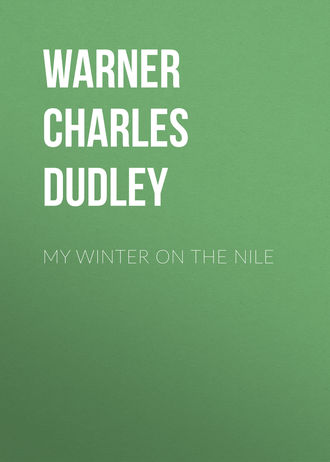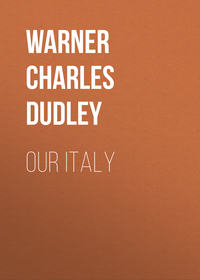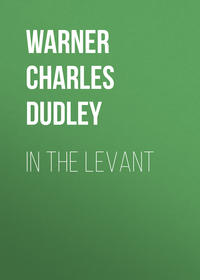 полная версия
полная версияMy Winter on the Nile
I am aware that every one who writes of the pyramids is expected to make a scene of the ascent, but if I were to romance I would rather do it in a fresher field. The fact is that the ascent is not difficult, unless the person is very weak in the legs or attempts to carry in front of himself a preposterous stomach. There is no difficulty in going alone; occasionally the climber encounters a step from three to four feet high, but he can always flank it. Of course it is tiresome to go up-stairs, and the great pyramid needs an “elevator”; but a person may leisurely zig-zag up the side without great fatigue. We went straight up at one corner; the guides insisting on taking me by the hand; the boosting Arab who came behind earned his money by grunting every time we reached a high step, but he didn’t lift a pound.
We stopped frequently to look down and to measure with the eye the mass on the surface of which we were like flies. When we were a third of the way up, and turned from the edge to the middle, the height to be climbed seemed as great as when we started. I should think that a giddy person might have unpleasant sensations in looking back along the corner and seeing no resting-place down the sharp edges of the steps short of the bottom, if he should fall. We measure our ascent by the diminishing size of the people below, and by the widening of the prospect. The guides are perfectly civil, they do not threaten to throw us off, nor do they even mention backsheesh. Stopping to pick out shells from the nummulitic limestone blocks or to try our glasses on some distant object, we come easily to the summit in a quarter of an hour.
The top, thirty feet square, is strewn with big blocks of stone and has a flag-staff. Here ambitious people sometimes breakfast. Arabs are already here with koollehs of water and antiquities. When the whole party arrives the guides set up a perfunctory cheer; but the attempt to give an air of achievement to our climbing performance and to make it appear that we are the first who have ever accomplished the feat, is a failure. We sit down upon the blocks and look over Egypt, as if we were used to this sort of thing at home.
All that is characteristic of Egypt is in sight; to the west, the Libyan hills and the limitless stretch of yellow desert sand; to the north, desert also and the ruined pyramid of Abooroâsh; to the south, that long necropolis of the desert marked by the pyramids of Abooseér, Sakkarah, and Dashoor; on the east, the Nile and its broad meadows widening into the dim Delta northward, the white line of Cairo under the Mokattam hills, and the grey desert beyond. Egypt is a ribbon of green between two deserts. Canals and lines of trees stripe the green of the foreground; white sails flicker southward along the river, winging their way to Nubia; the citadel and its mosque shine in the sun.
An Arab offers to run down the side of this pyramid, climb the second one, the top of which is still covered with the original casing, and return in a certain incredible number of minutes. We decline, because we don’t like to have a half-clad Arab thrust his antics between us and the contemplation of dead yet mighty Egypt. We regret our refusal afterwards, for there is nothing people like to read about so much as feats of this sort. Humanity is more interesting than stones. I am convinced that if Martha Rugg had fallen off the pyramid instead of the rock at Niagara Falls, people would have looked at the spot where she fell, and up at the stairs she came bobbing down, with more interest than at the pyramid itself. Nevertheless, this Arab, or another did, while we were there, climb the second pyramid like a monkey; he looked only a black speck on its side.
That accidents sometimes happen on the pyramids, I gather from the conversation of Hadji, who is full of both information and philosophy to-day.
“Sometime man, he fool, he go up. Man say, ‘go this way.’ Fool, he say, ‘let me lone.’ Umbrella he took him, threw him off; he dead in hundred pieces.”
As to the selling of Scarabæi to travelers, Hadji inclines to the side of the poor:—“Good one, handsome one,—one pound. Not good for much—but what to do? Gentleman he want it; man he want the money.”
For Murray’s’ Guide-Book he has not more respect than guides usually have who have acted as interpreters in the collection of information for it. For “interpret” Hadji always says “spell.”
“When the Murray come here I spell it to the man, the man to Murray and him put it down. He don’t know anything before. He told me, what is this? I told him what it is. Something,” with a knowing nod, “be new after Murray. Look here, Murray very old now.”
Hadji understands why the cost of living has gone up so much in Egypt. “He was very sheap; now very different, dearer—because plenty people. I build a house, another people build a house, and another people he build a house. Plenty men to work, make it dear.” I have never seen Hadji’s dwelling, but it is probably of the style of those that he calls—when in the street we ask him what a specially shabby mud-wall with a ricketty door in it is—“a brivate house.”
About the Great Pyramid has long waged an archaeological war. Years have been spent in studying it, measuring it inside and outside, drilling holes into it, speculating why this stone is in one position and that in another, and constructing theories about the purpose for which it was built. Books have been written on it, diagrams of all its chambers and passages, with accurate measurements of every stone in them, are printed. If I had control of a restless genius who was dangerous to the peace of society, I would set him at the Great Pyramid, certain that he would have occupation for a lifetime and never come to any useful result. The interior has peculiarities, which distinguish it from all other pyramids; and many think that it was not intended for a sepulchre mainly; but that it was erected for astronomical purposes, or as a witness to the true north, east, south, and west, or to serve as a standard of measure; not only has the passage which descends obliquely three hundred and twenty feet from the opening into the bed-rock, and permits a view of the sky from that depth, some connection with the observation of Sirius and the fixing of the Sothic year; not only is the porphyry sarcophagus that is in the King’s Chamber, secure from fluctuations of temperature, a fixed standard of measure; but the positions of various stones in the passages (stones which certainly are stumbling-blocks to everybody who begins to think why they are there) are full of a mystic and even religious signification. It is most restful, however, to the mind to look upon this pyramid as a tomb, and that it was a sepulchre like all the others is the opinion of most scholars.
Whatever it was, it is a most unpleasant place to go into. But we wanted one idea of’ Cimmerian darkness, and the sensation of being buried alive, and we didn’t like to tell a lie when asked if we had been in, and therefore we went. You will not understand where we went without a diagram, and you never will have any idea of it until you go. We, with a guide for each person, light candles, and slide and stumble down an incline; we crawl up an incline; we shuffle along a level passage that seems interminable, backs and knees bent double till both are apparently broken, and the torture of the position is almost unbearable; we get up the Great Gallery, a passage over a hundred and fifty feet long, twenty-eight high, and seven broad, and about as easy to ascend as a logging-sluice, crawl under three or four portcullises, and emerge, dripping with perspiration and covered with dust, into the king’s chamber, a room thirty-four feet long, seventeen broad, and nineteen high. It is built of magnificent blocks of syenite, polished and fitted together perfectly, and contains the lidless sarcophagus.
If it were anywhere else and decently lighted, it would be a stylish apartment; but with a dozen torches and candles smoking in it and heating it, a lot of perspiring Arabs shouting and kicking up a dust, and the feeling that the weight of the superincumbent mass was upon us, it seemed to me too small and confined even for a tomb. The Arabs thought they ought to cheer here as they did on top; we had difficulty in driving them all out and sending the candles with them, in order that we might enjoy the quiet and blackness of this retired situation. I suppose we had for once absolute night, a room full of the original Night, brother of Chaos, night bottled up for four or five thousand years, the very night in which old Cheops lay in a frightful isolation, with all the portcullises down and the passages sealed with massive stones.
Out of this blackness the eye even by long waiting couldn’t get a ray; a cat’s eye would be invisible in it. Some scholars think that Cheops never occupied this sarcophagus. I can understand his feeling if he ever came in here alive. I think he may have gone away and put up “to let” on the door.
We scrambled about a good deal in this mountain, visited the so-called Queen’s Chamber, entered by another passage, below the King’s, lost all sense of time and of direction, and came out, glad to have seen the wonderful interior, but welcoming the burst of white light and the pure air, as if we were being born again. To remain long in that gulf of mortality is to experience something of the mystery of death.
Ali Gobree had no antiquities to press upon us, but he could show us some choice things in his house, if we would go there. Besides, his house would be a cool place in which to eat our lunch. We walked thither, a quarter of a mile down the sand slope on the edge of the terrace. We had been wondering where the Sphinx was, expecting it to be as conspicuous almost as the Pyramids. Suddenly, turning a sand-hill, we came upon it, the rude lion’s body struggling out of the sand, the human head lifted up in that stiff majesty which we all know.
So little of the body is now visible, and the features are so much damaged that it is somewhat difficult to imagine what impression this monstrous union of beast and man once produced, when all the huge proportions stood revealed, and color gave a startling life-likeness to that giant face. It was cut from the rock of the platform; its back was patched with pieces of sandstone to make the contour; its head was solid. It was approached by flights of stairs descending, and on the paved platform where it stood were two small temples; between its paws was a sort of sanctuary, with an altar. Now, only the back, head and neck are above the drifting sand. Traces of the double crown of Upper and Lower Egypt which crowned the head are seen on the forehead, but the crown has gone. The kingly beard that hung from the chin has been chipped away. The vast wig—the false mass of hair that encumbered the shaven heads of the Egyptians, living or dead—still stands out on either side the head, and adds a certain dignity. In spite of the broken condition of the face, with the nose gone, it has not lost its character. There are the heavy eyebrows, the prominent cheek-bones, the full lips, the poetic chin, the blurred but on-looking eyes. I think the first feeling of the visitor is that the face is marred beyond recognition, but the sweep of the majestic lines soon becomes apparent; it is not difficult to believe that there is a smile on the sweet mouth, and the stony stare of the eyes, once caught, will never be forgotten.
The Sphinx, grossly symbolizing the union of physical and intellectual force, and hinting at one of those recondite mysteries which we still like to believe existed in the twilight of mankind, was called Hor-em-Khoo (“the Sun in his resting-place”), and had divine honors paid to it as a deity.
This figure, whatever its purpose, is older than the Pyramid of Cheops. It has sat facing the east, on the edge of this terrace of tombs, expecting the break of day, since a period that is lost in the dimness of tradition. All the achievements of the race, of which we know anything, have been enacted since that figure was carved. It has seen, if its stony eyes could see, all the procession of history file before it. Viewed now at a little distance or with evening shadows on it, its features live again, and it has the calmness, the simple majesty that belong to high art. Old writers say that the face was once sweet and beautiful. How long had that unknown civilization lasted before it produced this art?
Why should the Sphinx face the rising sun? Why does it stand in a necropolis like a sleepy warden of the dead who sleep? Was it indeed the guardian of those many dead, the mighty who slept in pyramids, in rock-hewn tombs, in pits, their bodies ready for any pilgrimage; and does it look to the east expecting the resurrection?
Not far from the Sphinx is a marvelous temple of syenite, which the sand almost buries; in a well in one of its chambers was found the splendid red-granite statue of Chephren, the builder of the second pyramid, a piece of art which succeeding ages did not excel. All about the rock plateau are tombs, and in some of them are beautiful sculptures, upon which the coloring is fresh. The scenes depicted are of common life, the occupations and diversions of the people, and are without any religious signification. The admirable sculptures represent no gods and no funeral mysteries; when they were cut the Egyptian theology was evidently not constructed.
The residence of our guide is a tomb, two dry chambers in the rock, the entrance closed by a wooden door. The rooms are large enough for tables and chairs; upon the benches where the mummies have lain, are piled antique fragments of all sorts, set off by a grinning skull or a thigh-bone; the floor is covered with fine yellow sand. I don’t know how it may have seemed to its first occupant, but we found it an excellent luncheon place, and we could sleep there calmly and securely, when the door was shut against the jackals—though I believe it has never been objected to a tomb that one couldn’t sleep in it. While we sip our coffee Ali brings forth his antique images and scarabæi. These are all genuine, for Ali has certificates from most of the well-known Egyptologists as to his honesty and knowledge of antiquities. We are looking for genuine ones; those offered us at the pyramids were suspicious. We say to Ali:—
“We should like to get a few good scarabæi; we are entirely ignorant of them; but we were sent to you as an honest man. You select half a dozen that you consider the best, and we will pay you a fair price; if they do not pass muster in Cairo you shall take them back.”
“As you are a friend of Mr. Blank,” said Ali, evidently pleased with the confidence reposed in him, “you shall have the best I have, for about what they cost me.”
The Scarabæus is the black beetle that the traveler will constantly see tumbling about in the sand, and rolling up balls of dirt as he does in lands where he has not so sounding a name. He was sacred to the old Egyptians as an emblem of immortality, because he was supposed to have the power of self-production. No mummy went away into the shades of the nether world without one on his breast, with spread-wings attached to it. Usually many scarabæi were buried with the mummy—several hundreds have been found in one mummy-case. They were cut from all sorts of stones, both precious and common, and made of limestone, or paste, hardened, glazed and baked. Some of them are exquisitely cut, the intaglio on the under side being as clean, true, and polished as Greek work. The devices on them are various; the name of a reigning or a famous king, in the royal oval, is not uncommon, and an authentic scarabæus with a royal name is considered of most value. I saw an insignificant one in soft stone and of a grey color, held at a hundred pounds; it is the second one that has ever been found with the name of Cheops on it. The scarabæi were worn in rings, carried as charms, used as seals; there are large coarse ones of blue pottery which seem to have been invitations to a funeral, by the inscriptions on them.
The Scarabæus is at once the most significant and portable souvenir of ancient Egypt that the traveler can carry away, and although the supply was large, it could not fill the demand. Consequently antique scarabæi are now manufactured in large quantities at Thebes, and in other places, and distributed very widely over the length of Egypt; the dealers have them with a sprinkling of the genuine; almost every peasant can produce one from his deep pocket; the women wear them in their bosoms.
The traveler up the Nile is pretty sure to be attacked with the fever of buying Scarabæi; he expects to happen upon one of great value, which he will get for a few piastres. It is his intention to do so. The Scarabæus becomes to him the most beautiful and desirable object in the world. He sees something fascinating in its shape, in its hieroglyphics, however ugly it may be to untaught eyes.
Ali selected our scarabæi. They did not seem to us exactly the antique gems that we had expected to see, and they did not give a high idea of the old Egyptian art. But they had a mysterious history and meaning; they had shared the repose of a mummy perhaps before Abraham departed from Ur. We paid for them. We paid in gold. We paid Ali for his services as guide. We gave him backsheesh on account of his kindness and intelligence, besides. We said good-bye to his honest face with regret, and hoped to see him again.
It was not long before we earnestly desired to meet him. He was a most accomplished fellow, and honesty was his best policy. There isn’t a more agreeable Bedawee at the Pyramids; and yet Ali is a modern Egyptian, just like his scarabæi, all the same. The traveler who thinks the Egyptians are not nimble-witted and clever is likely to pay for his knowledge to the contrary. An accumulated experience of five thousand years, in one spot, is not for nothing.
We depart from the pyramids amid a clamor of importunity; prices have fallen to zero; antiquities old as Pharaoh will be given away; “backsheesh, backsheesh, O Howadji;” “I havn’t any bread to mangere, I have six children; what is a piastre for eight persons?” They run after us, they hang upon the carriage, they follow us a mile, begging, shrieking, howling, dropping off one by one, swept behind by the weight of a copper thrown to them.
The shadows fall to the east; there is a lovely light on the plain; we meet long lines of camels, of donkeys, of fellaheen returning from city and field. All the west is rosy; the pyramids stand in a purple light; the Sphinx casts its shade on the yellow sand; its expectant eyes look beyond the Nile into the mysterious East.
CHAPTER IX.—PREPARATIONS FOR A VOYAGE
WE are giving our minds to a name for our dahabeëh. The owners have desired us to christen it, and the task is getting heavy. Whatever we are doing; guiding a donkey through the mazes of a bazaar; eating oranges at the noon breakfast; watching the stream of color and fantastic apparel, swaying camels and dashing harem-equipage with running saïses and outriding eunuchs, flowing by the hotel; following a wedding procession in its straggling parade, or strolling vacantly along, knocked, jostled, evaded by a dozen races in a dozen minutes and lost in the whirl, color, excitement of this perpetual masquerade, we are suddenly struck with, “what shall we call that boat?”
We want a name that is characteristic of the country and expressive of our own feelings, poetic and not sentimental, sensible and not common-place. It seems impossible to suggest a good name that is not already borne by a dahabeëh on the river—names such as the Lotus, the Ibis, the Gazelle, Cleopatra, Zenobia, names with an Eastern flavor. And we must have not only a name for the boat, but a motto or device for our pennant, or “distinguisher flag,” as the dragoman calls the narrow fifty feet long strip of bunting that is to stream from the forward yard. We carry at the stern the flag of our country, but we float our individuality in the upper air. If we had been a bridal party we should of course have taken some such device as that of a couple who went up the river under the simple but expressive legend of “Nestle-down,” written on their banner.
What would you name a Nile dahabeëh?
The days go all too rapidly for us to catch the shifting illusions about us. It is not so much what we see of the stated sights that can be described, but it is the atmosphere in which we live that makes the strangeness of our existence. It is as if we had been born into another world. And the climate is as strange as the people, the costumes, the habits, the morals. The calendar is bewitched. December is a mixture of September and July. Alas, yes. There are the night-fogs of September, and the mosquitoes of July. You cannot tell whether the season is going backwards or forwards. But for once you are content to let Providence manage it, at least so long as there is a north wind, and you forget that the sky has any shade other than blue.
And the prophecy of the poet is realized. The nights are filled with music, and the cares that infest the day are invariably put off till tomorrow, in this deliciously procrastinating land. Perhaps, however, Mr. Longfellow would not be satisfied with the music; for it seems to be the nasal daughter of Lassitude and Monotony, ancient gods of the East. Two or three strings stretched over a sounding skin and a parchment drum suffice to express the few notes that an Arab musician commands; harmony does not enter into his plan. Yet the people are fond of what they consider music. We hear on all sides at night the picking of strings, the throb of the darabooka and the occasional outburst of a wailing and sentimental strain. Like all barbarous music, this is always minor. When the performers are sailors or common strollers, it is doubtless exactly the same music that delighted the ancient Egyptians; even the instruments are the same, and the method of clapping the hands in accentuation of the music is unchanged.
There is a café chantant on one side of the open, tree-grown court of a native hotel, in the Ezbekeëh where one may hear a mongrel music, that is not inexpressive of both the morals and the mixed condition of Cairo to-day. The instruments of the band are European; the tunes played are Egyptian. When the first strain is heard we say that it is strangely wild, a weird and plaintive minor; but that is the whole of it. The strain is repeated over and over again for a half hour, as if it were ground out of a coffee-mill, in an iteration sufficient to drive the listener insane, the dissolute scraping and thumping and barbarous dissonance never changing nor ending. From time to time this is varied with singing, of the nasal, fine-tooth-comb order, with the most extraordinary attempts at shakes and trills, and with all the agony of a moonlit cat on a house-top. All this the grave Arabs and young Egyptian rakes, who sit smoking, accept with entire satisfaction. Later in the evening dancing begins and goes on with the strumming, monotonous music till at least the call for morning prayer.
In the handsome Ezbekeëh park or garden, where there are shady walks and some fine sycamores and banyans to be seen, a military band plays every afternoon, while the foreigners of both sexes, and Egyptian men promenade. Of course no Egyptian lady or woman of respectability is ever seen in so public a place. In another part of the garden, more retired, a native band is always playing at nightfall. In this sheltered spot, under the lee of some gigantic rock and grotto-work are tables and chairs, and a divan for the band. This rock has water pleasantly running through it, but it must have been struck by somebody besides Moses, for beer is brought out of its cool recesses, as well. Rows of men of all colors and costumes may be seen there, with pipe and mug and coffee cup; and on settees more elevated and next the grotto, are always sitting veiled women, in outer wrappers of black silk, sometimes open enough to show an underskirt of bright color and feet in white slippers. These women call for beer or something stronger, and smoke like the men; they run no risk in being in this publicity, for they have nothing to lose here or elsewhere. Opposite them on a raised divan, not unlike a roomy bedstead, sits the band.
It is the most disreputable of bands. Nothing in the whole East so expressed to me its fagged-out dissoluteness as this band and its performances. It is a sleepy, nonchalant band, as if it had been awake all the previous night; some of its members are blear-eyed, some have one eye, some have two; they are in turbans, in tarbooshes, in gowns of soiled silk, of blue cotton, of white drilling. It is the feeblest band; and yet it is subject to spurts of bacchantic fervor. Sometimes all the instruments are striving together, and then only one or two dribble the monotonous refrain; but somehow, with all the stoppings to light cigarettes and sip coffee, the tune is kept groaning on, in a minor that is as wild as the desert and suggestive of sin.





